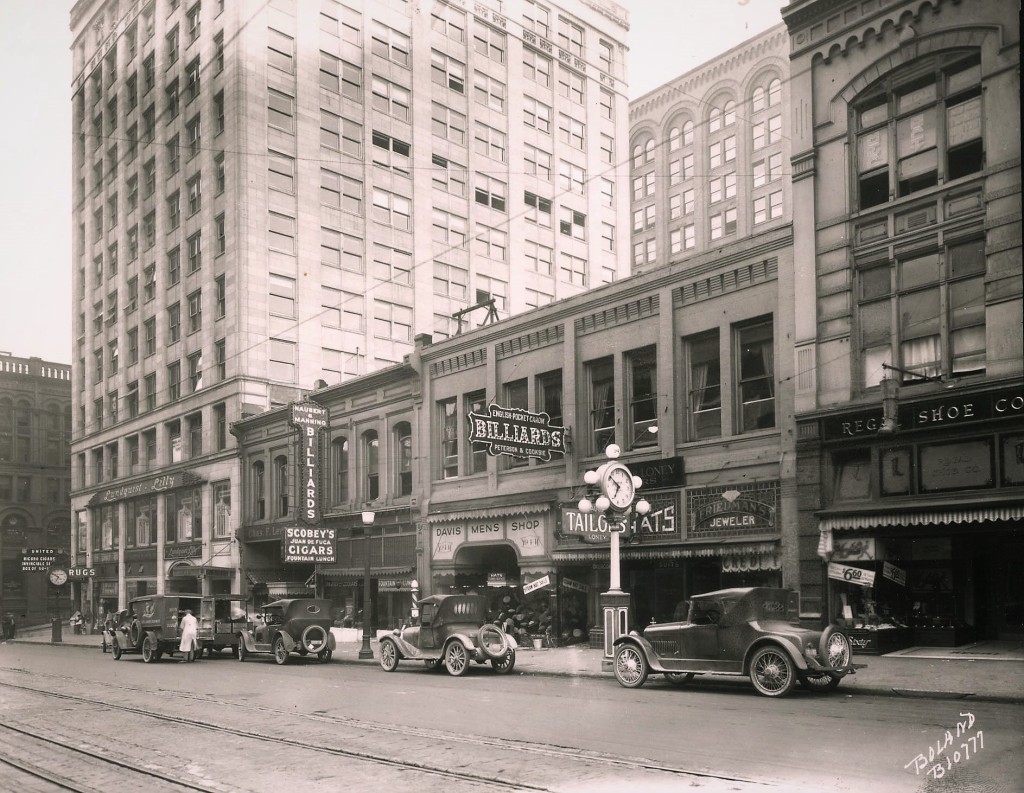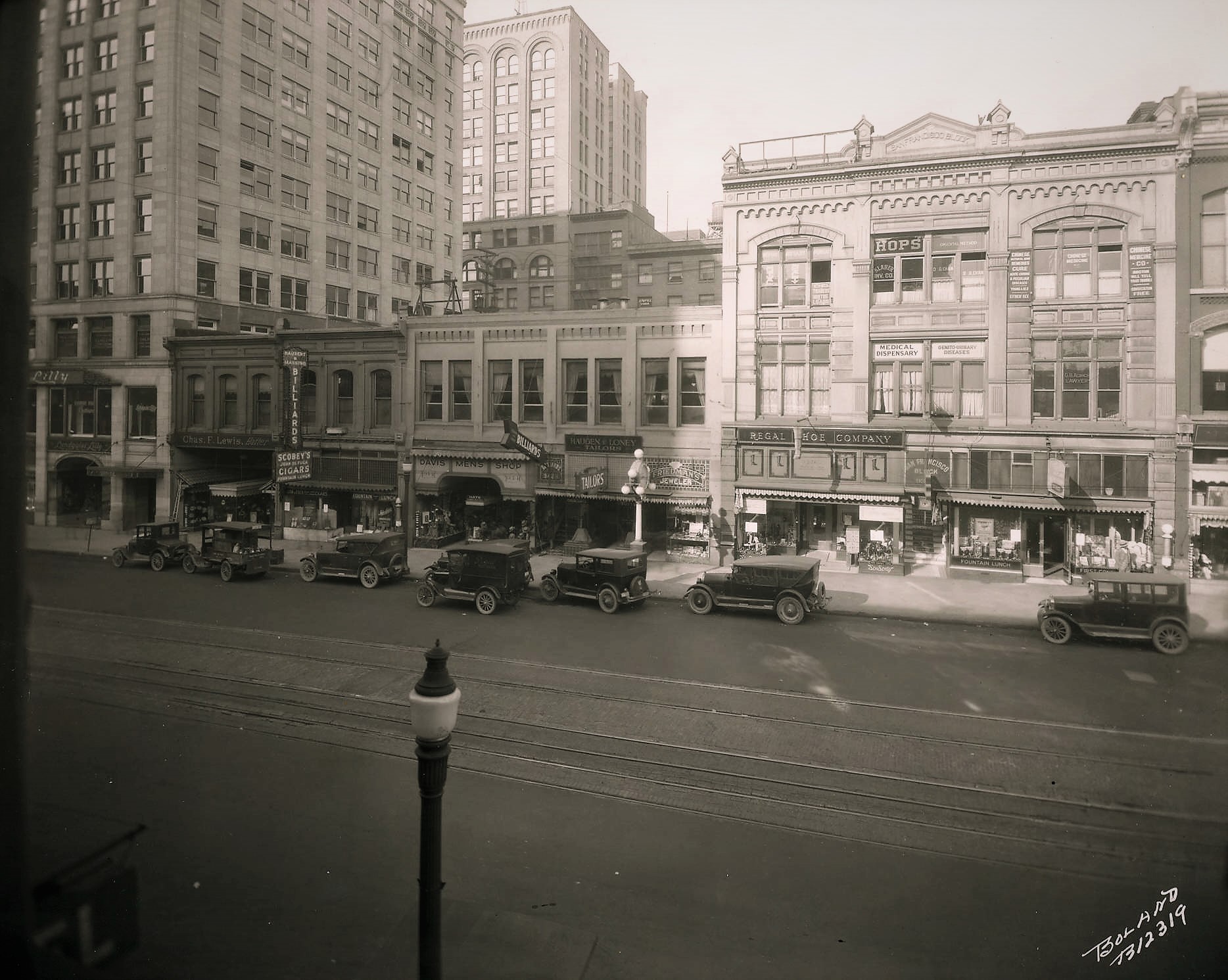

Midtown Tacoma on Tuesday April 14th 1925. Marvin Boland was up early with his large format camera on the second floor or roof of one of the low rise buildings on the east side of Pacific Avenue and 10th Street. The morning shadow of the scandalous Scandinavian American Bank Building divided the sunlight on a block of businesses in buildings that predated the hurried automobile age. These two and three story buildings were typical, if perhaps a bit smaller, than the tightly packed brick and stone facades that lined Tacoma’s most important boulevard and streetcar line. By the mid 1920’s, automobiles, buses and delivery truck were dodging in and out of the streetcars and beginning to change the daily patterns of the busy downtown. The hand laid brick and cut stone masonry commercial buildings from the railroad days were being overshadowed and dwarfed by the steel frame Chicago style skyscrapers around them.
The 1920’s were prosperous years for Tacoma’s merchants and to have a midtown Pacific Avenue address, even in a turn of the century building, was still a sign of credibility and means. Between 9th and 13th Streets the Pacific Avenue streetscape was lined with specialty retail shops-haberdashers, watchmakers, cobblers and woolen tailors. Captured in Boland’s sharp glass plate negative photo that morning is a snapshot of Tacoma’s merchant class and enterprise at the edge of a changing time .

Much can be gleaned from the type of businesses and signage, the ethnicity of the names in a time before big brands and fancy logos, and from their locations at street level or on the upper floors. There was a commercial coding to the block, a conversation in small change and folding money, a recognition of regular customers and smooth grifters. A stroll down the block headed north from left to right was a story.
The highest rent street level business was Lundquist-Lilly men’s clothing ion the new steel frame Rust Building on the corner of 11th. The hatter Charles F. Lewis was next door under a British style sign that carried his name across the entire 25 foot wide shop bay above a recessed entry and display windows. Haubert and Manning Billiards was one flight up above Scoby’s Juan De Fuca Cigar store, a barber shop and a lunch counter. This group of manly businesses shared a garish electric sign and created a

pocket of leisure in an otherwise busy working retail district. Davis Men’s Shop and Haugen and Loney Tailors came next, both selling suits, overcoats, hats and city style clothes to men. Friedman’s Jeweler was tucked into a 15 foot wide storefront with an understated but elegant cut glass transom sign. The jeweler’s primary marker was an extravagant curbside street clock festooned with illuminated globes and a glass faced open clockworks. Since 19th Century railroad days, Tacoma was known for its jewelers, many of them German and Swiss jews who were either watchmakers or retail jewelers and gem dealers. The watchsmiths were the elite in a city created by the railroad where time tables and telegraphic time signals were fundamental to daily operation. The Northern Pacific expected every employee to have a watch that kept “good time”. Even the shop crews were extended credit to buy a watch when they were first hired by the NP. Another Billiard parlor run by Peterson and Cookie filled the second floor above Friedman’s in the little building.
The stone faced San Francisco Block came next and was the most storied building in the group. Designed by the legendary architect August Darmer in 1887, it began life as the optimistic National Bank of Commerce which failed in the economic crash of 1893. At opening, the San Francisco Block was the first home for Tacoma’s Elks Lodge on the upper floor along with Howe’s book bindery. In Boland’s 1924 photo the top floor middle left window reads: Hops and Klaber Inv. Co. suggesting a broker in beer contents even though prohibition was in effect at the time.

Right next to the hop dealer on the top floor the window reads: Oriental Method and below: D.G. Chan. The top right window reads: Chinese Medicine. The two advertisements on either side say: Chinese Natural Method, Remedies, Cure, Acute- Chronic & Peculiar Diseases, Young & Old, Either Sex. Chinese Medicine Co., Doctor Will Tell Your Trouble, Consultation Free. With no elevator, the three story walk up probably led to very affordable office space for the practitioner in alternative medicine but the signage alone suggests a floor full of interesting odors and sounds.
The window signage on the second floor advertises Medical Dispensary; Genito-Urinary Diseases and next to that G. B. Aldrich, lawyer. Its a reminder that through the 1920’s and 30’s people came downtown daily for more than just shopping. The business of daily lives pulsed into and away from the downtown every hour. Teeth got pulled, wills were made out, land was bought and sold and insurance claims were filed every day in the upper floors along Pacific Avenue. It was a routine of streetcars, pedestrians and 3 to 5 story commercial walk up office buildings with ground floor retail on the east and west street fronts. Along this west side block the better retailers and upper floor entrance fronted on the Pacific Avenue streetcar line while the grittier businesses faced Commercial street on the rear.
About four years before the Boland photo, just as construction was starting on the Rust Building, the Regal Shoe Company opened on the ground floor of the San Francisco Building. They spent an astonishing $8000 finishing out their shop with carved hardwood cabinetry, special electric display lighting and a giant boot that hung over the sidewalk along with a gold leaf sign. In the years and decades to come none of the other merchants and upper floor professionals would last as long as Regal Shoes. During the war, the building was sold (for $85,000) and just after the war the Murphy’s Cigar Store next door was raided for gambling and “vice”. It got converted into a

glass block fronted restaurant and cocktail lounge that was opened 24 hours a day and got raided again. Regal Shoes hung on into the late 1960’s, surviving as merchants on Pacific Avenue for almost half a century. In 1969 the group of buildings and businesses in Marvin Boland’s photograph were demolished to make way for a parking garage.


any way you can make it so if we click on a photo it expands so we can see more details? that would be awesome..
LikeLike
I’ll play around with the settings but in the wordpress template I believe the images are locked in at the size/resolution you see on your browser. You can adjust the magnification on your browser in settings to look closer. Sorry.
LikeLike
Gosh we have so many empty parking lots where these types of beautiful and human oriented buildings once were, it’s time to bring them back! The apartment boom going on downtown is good for sure but it would be nice to have merchant blocks and mixed use brick buildings echoing our history imo.
LikeLike
My grandfather’s shop I.M. Larsen & Sons was on A Street right across from the totem pole and cannon. I was razed in 1968 for that bank building that’s there now.
LikeLike
Anyone know of a Hubbard Piano or Music Company/Store etc that existed in Tacoma during the first half of the 1900s?
LikeLiked by 1 person